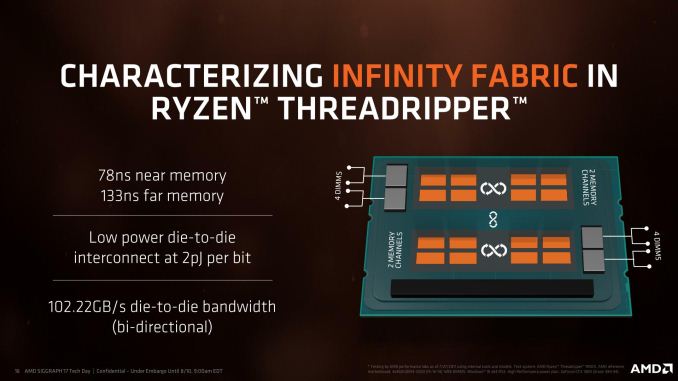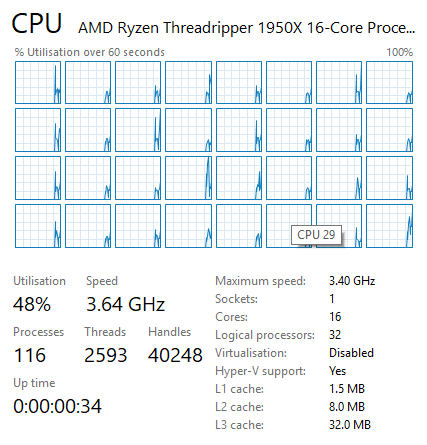The AMD Ryzen Threadripper 1950X and 1920X Review: CPUs on Steroids
by Ian Cutress on August 10, 2017 9:00 AM ESTSilicon, Glue, & NUMA Too
In the Ryzen family, AMD designed an 8 core silicon die known as a Zeppelin die. This consisted of two core complexes (CCX) of four cores each, with each CCX having access to 8 MB of L3 cache. The Zeppelin die had access to two DRAM channels, and was fixed with 16 PCIe lanes for add-in cards. With Threadripper, AMD has doubled up the silicon.
If you were to delid a Threadripper CPU, you would actually see four silicon dies, similar to what an EPYC processor would have, making Threadripper a Multi Core Module (MCM) design. Two of these are reinforcing spacers – empty silicon with no use other than to help distribute the weight of the cooler and assist in cooling. The other two dies (in opposite corners for thermal performance and routing) are basically the same Zeppelin dies as Ryzen, containing eight cores each and having access to two memory channels each. They communicate through Infinity Fabric, which AMD lists as 102 GB/s die-to-die bandwidth (full duplex bidirectional), along with 78ns to reach the near memory (DRAM connected to the same die) and 133ns to reach the far memory (DRAM on another die). We confirmed those numbers on DDR4-2400 memory, also achieving 65 ns and 108 ns respectively using DDR4-3200.

Despite this AMD slide showing two silicon dies, there are four units of silicon in the package. Only two of the dies are active, so AMD has 'simplified' the diagram'
By comparison, EPYC lists die-to-die bandwidth as 42.6 GB/s at DDR4-2666. This is because EPYC runs fabric links to three dies internally and one die externally (on the next socket), which maximizes all the links available. The dies in Threadripper only have to communicate with one other die, so has more flexibility. To that extent, we’re under the impression that Threadripper is using two of these links at 10.4 GT/s using the following method:
- Die to Die for EPYC is quoted as 42.6 GB/s at DDR4-2667
- Die to Die for Threadripper is quoted as 102.2 GB/s at DDR4-3200
- 42.6 GB/s * 2 links * 3200/2667 = 102.2 GB/s
- 42.6 GB/s * 3 links * 3200/2667 at 8.0 GT/s = 115.8 GB/s (too high)
- 42.6 GB/s * 3 links * 3200/2667 at 6.4 GT/s = 92.6 GB/s (too low)
This configuration for AMD is essentially what the industry calls a NUMA configuration: non-uniform memory access. If left as it, it means that code cannot rely on a regular (and low) latency between requesting something from DRAM and receiving it. This can be an issue for high-performance code, which is why some software is designed NUMA-aware, so that it can intelligently pin the memory it needs to the closest DRAM controller, lowering potential bandwidth but prioritizing latency.
NUMA is nothing new in the x86 space. Once CPUs began shipping with on-die memory controllers rather than using an off-die memory controller in the Northbridge, NUMA became an inherent part of multi-socket systems. In this respect AMD was the leader here right from the start, as they beat Intel to on-die memory controllers for x86 CPUs by years. So AMD has been working with NUMA for years, and similarly NUMA has been the state of affairs for Intel's multi-socket server systems for almost a decade.
What's new with Threadripper however is that NUMA has never been a consumer concern. MCM consumer CPUs have been few and far between, and we'd have to go all the way back to the Core 2 Quad family to find a CPU with cores on multiple dies, which was a design that predates on-die memory controllers for Intel. So with Threadripper, this is the very first time that consumers – even high-end consumers – have been exposed to NUMA.
But more importantly, consumer software has been similarly unexposed to NUMA, so almost no software is able to take its idiosyncrasies into account. The good news is that while NUMA changes the rules of the game a bit, it doesn't break software. NUMA-aware OSes do the heavy lifting here, helping unaware software by keeping threads and memory accesses together on the same NUMA node in order to ensure classic performance characteristics. The downside to this is that much like an overprotective parent, the OS is going discourage unaware software from using other NUMA nodes. Or in the case of Threadripper, discouraging applications from using the other die and its 8 cores.

At a hardware level, Threadripper is natively two NUMA nodes
In an ideal world, all software would be NUMA-aware, eliminating any concerns over the matter. From a practical perspective however, software is slow to change and it seems unlikely that NUMA-style CPUs are going to become common in the future. Furthermore NUMA can be tricky to program for, especially in the case of workloads/algorithms that inherently struggle with "far" cores and memory. So the quirks of NUMA are never going to completely go away, and instead AMD has taken it upon themselves to manage the matter.
AMD has implemented BIOS switches and software switches in order to better support and control the NUMAness of Threadripper. By default, Threadripper actually hides its NUMA architecture. AMD instead runs Threadripper in a UMA configuration: a uniform memory access system where memory is sent to any DRAM and the return is variable in latency (e.g. ~100ns averaging between 78ns and 133ns) but focusing for a high peak bandwidth. By presenting the CPU to the OS as a monolithic, single-domain design, memory bandwidth is maximized and all applications (NUMA-aware and not) see all 16 cores as part of the same CPU. So for applications that are not NUMA-aware – and consequently would have been discouraged by the OS in NUMA mode – this maximizes the number of cores/threads they can use and the memory bandwidth they can use.

All 32 threads are exposed as part of a single monolithic CPU
The drawback to UMA mode is that because it's hiding how Threadripper really works, it doesn't allow the OS and applications to make fully informed decisions for themselves, and consequently they may not make the best decisions. Latency-sensitive NUMA-unaware applications that fare poorly with high core/memory latencies can struggle here if they use cores and memory attached to the other die. Which is why AMD also allows Threadripper to be configured for NUMA mode, exposing its full design to the OS and resulting in separate NUMA domains for the two dies. This informs the OS to keep applications pinned to one die when possible as previously discussed, and this mode is vital for some software and some games, and we’ve tested it in this review.
Overall, using a multi-silicon design has positives and negatives. The negatives end up being variable memory latency, variable core-to-core latency, and often redundancy in on-die units that don’t need to be repeated. As a result, AMD uses 400mm2+ of silicon to achieve this, which can increase costs at the manufacturing level. By contrast, the positives are in silicon design and overall yeilds: being able to design a single piece of silicon and repeat it, rather than design several different floor plans which multiplies up the design costs, and having the (largely) fixed number of wafer defects spread out over many more smaller dies.
By contrast, Intel uses a single monolithic die for its Skylake-X processors: the LCC die up to 10-core and HCC die from 12-core up to 18-core. These use a rectangular grid of cores (3x4 and 5x4 respectively), with two of the segments reserved for the memory controllers. In order to communicate between the cores, Intel uses a networking mesh, which determines which direction the data needs to travel (up, down, left, right, or accepted into the core). We covered Intel’s MOdular Decoupled Crossbar (MoDe-X) methodology in our Skylake-X review, but the underlying concept is consistency. This mesh runs at 2.4 GHz nominally. Prior to Skylake-X, Intel implemented a ring topology, such that data would have to travel around the ring of cores to get to where it needed to go.
With reference to glue, or glue-logic, we’re referring to the fabric of each processor. For AMD that’s the Infinity Fabric, which has to travel within the silicon die or out to the other silicon die, and for Intel that’s the internal MoDe-X mesh. Elmer’s never looked so complicated.











347 Comments
View All Comments
lefty2 - Thursday, August 10, 2017 - link
except that they haven'tDr. Swag - Thursday, August 10, 2017 - link
How so? You have the performance numbers, and they gave you power draw numbers...bongey - Thursday, August 10, 2017 - link
Just do a avx512 benchmark and Intel will jump over 300watts , 400watts(overclocked) only from the cpu. (prime95 avx512 benchmark).See der8auer's video "The X299 VRM Disaster (en)"DanNeely - Thursday, August 10, 2017 - link
The Chromium build time results are interesting. Anandtech's results have the 1950X only getting 3/4ths of the 7900X's performance. Arstechnica's getting almost equal results on both CPUs, but at 16 compiles per day vs 24 or 32 is seeing significantly worse numbers all around.I'm wondering what's different between the two compile benchmarks to see such a large spread.
cknobman - Thursday, August 10, 2017 - link
I think it has a lot to do with the RAM used by Anandtech vs Arstechnica .For all the regular benchmarking Anand used DDR4 2400, only the DDR 3200 was used in some overcloking.
Arstechnica used DDR4 3200 for all benchmarking.
Everyone already knows how faster DDR4 memory helps the Zen architecture.
DanNeely - Thursday, August 10, 2017 - link
If ram was the determining factor, Ars should be seeing faster build times though not slower ones.carewolf - Thursday, August 10, 2017 - link
Anandtech must have misconfigured something. Building chromium is scales practically linearly. You can move jobs all the way across a slow network and compile on another machine and you still get linear speed-ups with more added cores.Ian Cutress - Thursday, August 10, 2017 - link
We're using a late March v56 code base with MSVC.Ars is using a newer v62 code base with clang-cl and VC++ linking
We locked in our versions when we started testing Windows 10 a few months ago.
supdawgwtfd - Friday, August 11, 2017 - link
Maybe drop it then as it is not at all usefull info.Johan Steyn - Thursday, August 10, 2017 - link
I refrained from posting on the previous article, but now I'm quite sure Anand is being paid by Intel. It is not that I argue against the benchmarks, but how it is presented. I was even under the impression that this was an Intel review.The previous article was stated as "Introducing Intel's Desktop Processor" Huge marketing research is done on how to market products. By just stating one thing first or in a different way, quite different messages can be conveyed without lying outright.
By making the "Most Powerful, Most Scalable" Bold, that is what the readers read first, then they read "Desktop Processor" without even reading that is is Intel's. This is how marketing works, so Anand used slanted journalism to favour Intel, yet most people will just not realise it eat it up.
In this review there are so many slanted journalism problems, it is just sad. If you want, just compare it to other sites reviews. They just omit certain tests and list others at which Intel excel.
I have lost my respect for Anandtech with these last two articles of them, and I have followed Anandtech since its inception. Sad to see that you are also now bought by Intel, even though I suspected this before. Congratulations for making this so clear!!!